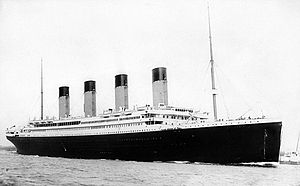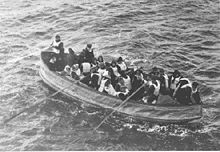Titanic: Not Unsinkable After All
The Titanic, the so-called "unsinkable ship," struck an iceberg on April 15, 1912, and sunk to the bottom of the ocean, claiming the lives of more than 1,500 of the 2,220 people onboard. The ship's designers, paid well by the White Star Line, went out of their way to tell the world that the construction was safe and sound for the voyage across the northern Atlantic Ocean, from Southampton, England, to New York. The designers were so convinced of the infallibility of their design that they included only 20 lifeboats, enough for one-third of the people onboard to vacate the ship if necessary. On April 10, the giant ship left port. After four days, the unthinkable happened and the unsinkable ship sank, having struck a large iceberg that ripped large enough holes in the lower decks to split the ship in half. The collision occurred 375 miles south of Newfoundland and caused several of the ship's watertight compartments to open, allowing water to rush in and trapping many people on the lower decks.
In many ways, the Titanic passenger list reflected the wide class divide of the times. Of the 1,296 total passengers onboard the massive ocean liner, 319 were labeled as first class, 269 were termed second class, and 699 were called third class, or steerage. 
A closer look at the casualty figures reveals that of the 319 first-class passengers, 200 survived and of the 269 second-class passengers, 117 survived. Only 172 of 699 third-class passengers survived. A similar percentage can be found among crew and staff: 215 of 918 survived. This happened for a few reasons, most notably that the first-class passengers were, by and large, the first ones into the lifeboats. Of the 20 lifeboats onboard, 18 were set afloat. All but three of the lifeboats had a capacity of 65 (the others could carry 40), but very few lifeboats began their journeys away from the sinking ship with 65 people aboard. First-class passengers only were allowed on the first several lifeboats. Second-class passengers were on the eighth lifeboat to launch, and third-class passengers were not on a lifeboat until the 12th one to go. Another contributing factor to the death of so many third-class passengers was the public health law that required the locking of gates that separate these lower-deck passengers from the "higher" classes. The Titanic had struck the iceberg at 11.40 p.m. on the night of April 14. About 2:20 a.m. the next morning, the boat broke apart and sank, bow-first, with more than 1,000 people still onboard. The water was freezing, and hundreds of people died quickly from hypothermia. Survivors were eventually rescued by crew aboard another large ship, the Carpathia. |
|
Social Studies for Kids
copyright 2002–2026
David White




 Only 18 of the 20 lifeboats were launched, and none of them were filled to capacity. Some had only 20 or 30 people onboard, and the population of lifeboats was top-heavy in terms of class, with many more first-class passengers than anyone else. (This eyewitness account from a survivor says that only 36 people were in her lifeboat.)
Only 18 of the 20 lifeboats were launched, and none of them were filled to capacity. Some had only 20 or 30 people onboard, and the population of lifeboats was top-heavy in terms of class, with many more first-class passengers than anyone else. (This eyewitness account from a survivor says that only 36 people were in her lifeboat.)
